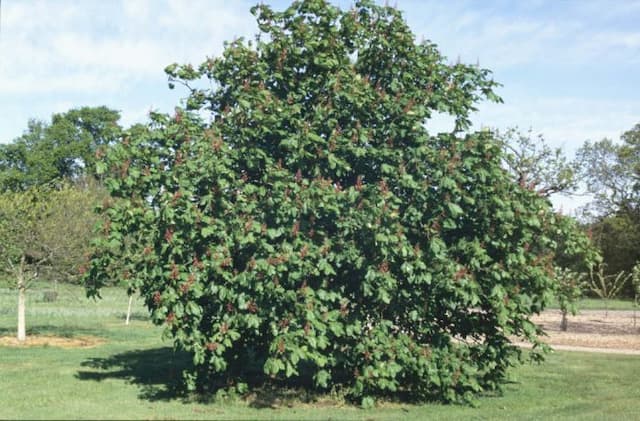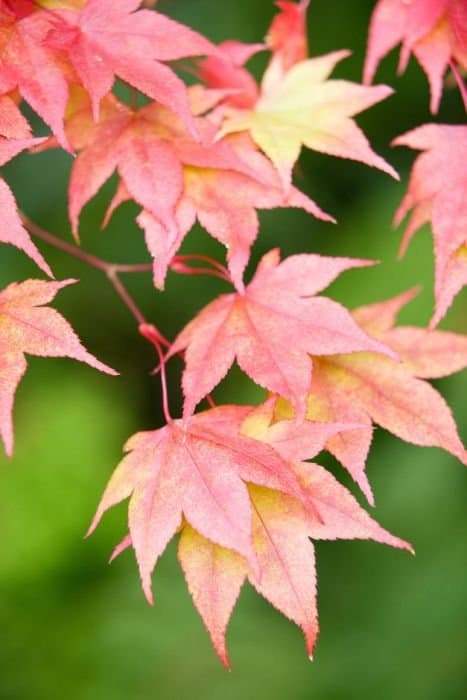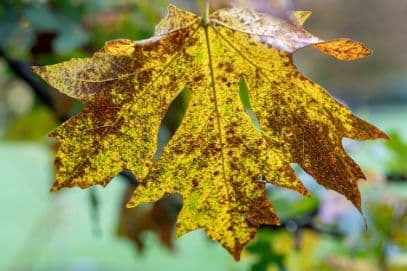Japanese Maple Acer palmatum 'Beni-otake' (L)

ABOUT
Acer palmatum 'Beni-otake', commonly known as Japanese Maple, is a visually striking plant. This cultivar is known for its unique and attractive foliage. The leaves are deeply lobed, almost feather-like in appearance, and they emerge in spring with a vibrant, fiery red hue, which is implied by its name 'Beni-otake' meaning "big red bamboo" in reference to the color and linear form of the leaves. Each leaf typically has five to seven pointed lobes that spread outward like the palm of a hand, lending to the name "palmatum." As the seasons change, the foliage undergoes subtle transformations in color. During the summer months, the leaves may retain their red color or slightly darken, providing a continuous display of rich color in the garden landscape. When autumn arrives, the Japanese Maple takes on a spectacular show as the leaves turn to glowing shades of red, providing a dramatic contrast to the surrounding greenery and the possible fall colors of other plants. The texture of the leaves is smooth, and they have a somewhat delicate appearance, contributing to the overall elegance of the tree. The branching pattern is typically graceful, with branches that may weep or cascade, giving the plant a serene, sculptural quality. The bark of this Japanese Maple is usually a subdued gray, providing a pleasant contrast to the brightness of the leaves and allowing them to be the visual focus. Flowers and fruits on the Japanese Maple are generally not the primary attraction since they are small and not prominently displayed. This plant is primarily appreciated for its leaf color and form, which are the main features that gardeners and landscaping enthusiasts seek to incorporate into their designs for ornamental appeal. Overall, the Acer palmatum 'Beni-otake' adds an element of bold color, fine texture, and artistic shape to gardens or containers, contributing to a vibrant aesthetic throughout the growing seasons with its ever-changing palette of reds.
About this plant
 Names
NamesFamily
Sapindaceae
Synonyms
Japanese Maple, Red Bamboo Maple
Common names
Acer palmatum 'Beni-otake'.
 Toxicity
ToxicityTo humans
Japanese Maple is not known to be toxic to humans. Therefore, ingestion of parts of this plant typically does not result in poisoning or adverse symptoms.
To pets
Japanese Maple is generally considered non-toxic to pets as well. Ingesting this plant should not cause any significant symptoms of poisoning in animals such as cats and dogs. However, individual animals may have varying sensitivities, and ingesting plant material can sometimes lead to mild gastrointestinal upset.
 Characteristics
CharacteristicsLife cycle
Perennials
Foliage type
Deciduous
Color of leaves
Red
Height
15 feet (4.57 meters)
Spread
10 feet (3.05 meters)
Plant type
Tree
Hardiness zones
5
Native area
Japan
Benefits
 General Benefits
General Benefits- Aesthetic Appeal: Acer palmatum 'Beni-otake', commonly known as Japanese Maple, offers stunning red-purple foliage that adds dramatic color contrast in gardens and landscapes.
- Seasonal Interest: Throughout the seasons, the leaves of the Japanese Maple change hues, displaying vibrant colors that add visual interest to any outdoor space.
- Cultural Significance: Japanese Maples have been cultivated for centuries in Japan and are associated with peace and serenity, making them a symbolic addition to gardens.
- Versatility in Landscaping: These trees can be used in various landscaping designs, from traditional to contemporary, functioning as focal points, hedges, or even in bonsai form.
- Shade Provision: In addition to their beauty, Japanese Maples create a canopy of shade, offering respite on sunny days and increasing the comfort of outdoor areas.
- Wildlife Support: The tree provides habitat and food for birds and small mammals, thereby supporting local biodiversity.
- Urban Tolerance: Despite its delicate appearance, the Japanese Maple is quite tolerant of urban pollution, making it suitable for city environments.
- Low Maintenance: Acer palmatum 'Beni-otake' is relatively low maintenance compared to other ornamental trees, requiring minimal pruning and care once established.
 Medical Properties
Medical Properties- This plant is not used for medical purposes.
 Air-purifying Qualities
Air-purifying QualitiesThis plant is not specifically known for air purifying qualities.
 Other Uses
Other Uses- Acer palmatum 'Beni-otake' can be used in bonsai creation due its attractive foliage and branching patterns, which allow enthusiasts to shape it into miniature tree forms.
- The strong and flexible branches of this Japanese Maple are sometimes harvested to create natural supports or stakes for other garden plants.
- The vibrant leaves of 'Beni-otake' are used in decorative arrangements, especially in autumn when leaves change color, to add a seasonal touch to interior decor.
- In photography, the Japanese Maple serves as a striking subject or backdrop, particularly during fall with its deep red foliage creating a dramatic contrast.
- Artists often use the intricate patterns and rich colors of the 'Beni-otake' leaves as inspiration for paintings, textiles, and other art forms.
- Gardeners may use the dry, fallen leaves of the Japanese Maple as a mulch to protect and enrich the soil around other plants.
- Leaves from 'Beni-otake' can be included in compost piles as a source of carbon, helping to balance the compost's nutrient content.
- The tree's aesthetically pleasing structure and coloration make it a popular choice for traditional Japanese garden settings, contributing to the garden's zen and harmony.
- Craftsmen may use the wood from pruned branches for making small wooden items, such as buttons, due to its fine grain and workability.
- In educational settings, the Japanese Maple can be used to teach about plant physiology and seasonal changes, as it exhibits notable changes throughout the year.
Interesting Facts
 Feng Shui
Feng ShuiThe Japanese Maple, which is the most common name for Acer palmatum 'Beni-otake', is often used in Feng Shui for its beautiful, deeply colored leaves which can bring a sense of balance and harmony to a garden space. It signifies peaceful energy and its element is Wood, which promotes growth and vitality. Placing a Japanese Maple in the East sector of a garden can foster health and family harmony, while positioning it in the Southeast can attract wealth and abundance.
 Zodiac Sign Compitability
Zodiac Sign CompitabilityThe Japanese Maple is not used in astrology practice.
 Plant Symbolism
Plant Symbolism- Endurance and Strength - The Acer palmatum 'Beni-otake', commonly known as Japanese Maple, often symbolizes endurance and strength due to its ability to withstand diverse weather conditions and its sturdy growth.
- Peace and Tranquility - The delicate foliage and elegant shape of the Japanese Maple bring a sense of calm and serenity to gardens, representing peace and tranquility.
- Beauty and Grace - Known for its beautiful red leaves, the Japanese Maple is associated with beauty and grace, often reflecting the aesthetic appreciation in Japanese culture.
- Balance and Practicality - The balanced and attractive shape of the tree, along with its practical uses in landscaping, suggests symbolism of balance and practicality in life.
- Change and Transition - As the Japanese Maple's leaves change color throughout the seasons, they represent change and transition, highlighting the impermanence and cyclical nature of life.
 Water
WaterThe Japanese Maple 'Beni-otake' should be watered regularly, especially during dry spells, to keep the soil moist but not waterlogged. Generally, this means watering once or twice a week deeply with 1 to 2 gallons of water each time, depending on weather conditions and soil drainage. It is crucial to avoid overhead watering to prevent leaf scorch and fungal diseases. During the winter months, reduce the amount of water since the plant will be in dormancy. Always check the top few inches of soil for dryness before watering.
 Light
LightThe Japanese Maple 'Beni-otake' prefers a spot that offers partial shade, especially in the afternoon, to protect its delicate leaves from harsh sunlight. Morning sun with afternoon shade or dappled sunlight throughout the day is ideal for promoting vibrant leaf color while preventing leaf burn. Avoid deep shade as it can lead to leggy growth and diminished foliage coloring.
 Temperature
TemperatureJapanese Maple 'Beni-otake' thrives in temperatures between 60°F and 80°F for optimal growth. While it can tolerate a range from 20°F to 90°F, extreme temperatures on either end can cause damage. The plant prefers cooler climates and may struggle with the heat and humidity if the temperature consistently exceeds 85°F.
 Pruning
PruningPrune your Japanese Maple 'Beni-otake' to maintain its shape, remove any dead or damaged branches, and to encourage healthy growth. Pruning is best done in late winter or early spring before new growth starts. Light pruning can also be done during summer if necessary. The best time for major pruning is when the tree is dormant to minimize stress and sap loss.
 Cleaning
CleaningAs needed
 Soil
SoilThe Japanese Maple 'Beni-otake' prefers well-draining, acidic to neutral soil with a pH between 5.5 and 7.5. A mix of 1/3 peat, 1/3 pine bark, and 1/3 coarse sand or perlite creates an ideal environment.
 Repotting
RepottingJapanese Maples should be repotted every 2-3 years to prevent root binding, ideally during late winter or early spring before new growth begins.
 Humidity & Misting
Humidity & MistingThe 'Beni-otake' Japanese Maple enjoys moderate humidity levels, ideally between 40% and 60%, and should be protected from excessive dryness.
 Suitable locations
Suitable locationsIndoor
Provide bright, indirect light and protect from strong sun.
Outdoor
Plant in dappled shade, shield from harsh winds.
Hardiness zone
5-8 USDA
 Life cycle
Life cycleJapanese Maple 'Beni-otake' begins its life cycle with seed germination, which is fostered by stratification to break seed dormancy. Following germination, the seedling stage involves the growth of basic root and shoot systems. As the plant enters the juvenile phase, the characteristic palmate leaves emerge, displaying a deep red or purple color, and the plant begins to develop its woody structure. The mature phase is marked by the tree reaching its full size, about 15-20 feet tall, and it starts to reproduce by producing flowers followed by winged samaras (seed pods). After the reproductive phase, which can last for several decades, the tree will eventually enter a period of senescence, where growth slows and the tree may become more susceptible to environmental stresses, pests, and diseases. The life cycle concludes when the tree dies, at which point it decomposes and returns nutrients to the soil, potentially aiding the growth of new plants.
 Propogation
PropogationPropogation time
Late spring to early summer
The Japanese Maple 'Beni-otake' is most commonly propagated through grafting, which is best done in late winter before the sap starts to flow. In this method, a piece of a stem with leaf buds, known as a scion, is inserted into the stock of another plant. The scion should be around 2 to 6 inches (approximately 5 to 15 centimeters) in length. The graft union is then wrapped with grafting tape to hold it securely in place while the scion fuses with the rootstock over a period of weeks to months. Grafting allows for the replication of the precise characteristics of 'Beni-otake' since it involves physically joining the tissues of two plants so they grow as one. This method is preferred as it also provides a strong root system from the stock plant, ensuring more robust growth.








